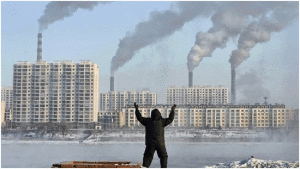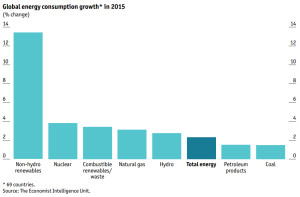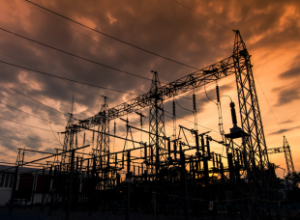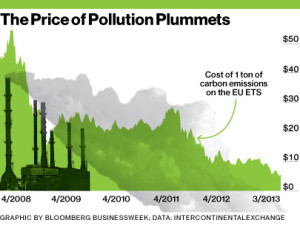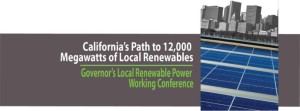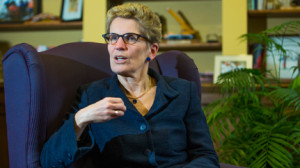RE and EE Carbon Policy news 16 February 2015
Weekly RE and EE Carbon Policy news update from the web.
C2ES study identifies lessons from carbon pricing for business and policy

A new C2ES report highlights lessons useful for companies and policymakers as more states and countries consider carbon pricing to spur innovative technologies and cut emissions at the lowest possible cost.
The report, written for the World Bank’s Partnership for Market Readiness (PMR), examines how three companies — Pacific Gas and Electric (PG&E), Rio Tinto, and Royal Dutch Shell — prepared for carbon pricing programs.
The PMR shares this type of information with developing countries to help them create their own market-based policies. We were pleased to partner with the PMR to explore how a few of the companies in our Business Environmental Leadership Council prepared for carbon pricing and we thank the companies for sharing their expertise.
The new European energy efficiency facility is here: financing sustainable energy at the local and regional level!

The European Energy Efficiency Facility (EEE – F) of the European Energy Programme for Recovery (EEPR) is a new financial facility dedicated to sustainable energy.
Why is a European Energy Efficiency facility being set up?
The Council of Ministers and the European Parliament agreed in December 2010 to a European Commission proposal, made the same year in May, to allocate approximately EUR 146 million from the European Energy Programme for Recovery (i.e. 3.7% of the total EEPR envelope) towards a new financial facility dedicated to sustainable energy. The EU contribution comes from funds mobilised for the EEPR in 2009 which could not immediately be allocated to projects in the sectors of infrastructure, off-shore wind and carbon capture and storage (CCS).
What structure will the new financial facility have?
The new facility will take the form of an investment fund complemented by technical assistance (TA) and awareness raising. The EU will contribute about EUR 146 million to the facility, of which about EUR 125 million to the fund and about EUR 20 million to TA.
Energy efficiency industry needs to talk securitization

What do leaders in the banking industry think about the potential of privately financing solar power, wind energy and energy efficiency? In this interview with Clean Energy Finance Forum, Michael Eckhart, managing director and global head of finance and sustainability at Citigroup, shares his optimism about the transition to clean energy and his observations about the persistent obstacles in the market — including the need to scale up financing for energy efficiency.
Citigroup has participated in public-private efforts helping to catalyze advancement in this arena. Eckhart describes progress in the context of a 100-year transition toward a clean energy economy. Developments in standardization and securitization hold tremendous potential for moving the industry forward.
Clean Energy Finance Forum: Do you believe the private sector is underinvesting in clean energy and energy efficiency? If so, why?
Eckhart: No, not underinvesting. The private sector invests in those projects that meet the criteria for financing.
How Efficient Is Energy Efficiency? A New Freakonomics Radio Podcast

Arik Levinson is an environmental economist at Georgetown who spent some time as a senior economist for environmental issues with the Council of Economic Advisors (C.E.A.) under President Obama.
“One of my jobs,” he says, “was helping the White House evaluate the environmental policies coming out of the Department of Transportation, the Department of Energy, and the Environmental Protection Agency. And I quickly realized that most of the policies that I was seeing involved energy efficiency.”
So Levinson wanted to know: how efficient is all this energy efficiency? That’s the topic of our latest podcast. (You can subscribe to the podcast at iTunes or elsewhere, get the RSS feed, or listen via the media player above. You can also read the transcript, which includes credits for the music you’ll hear in the episode.)
We discuss Levinson’s new working paper “How Much Energy Do Building Energy Codes Really Save? Evidence From California” (and a related Journal of Economic Behavior& Organization paper, called “California Energy Efficiency: Lessons for the Rest of the World, or Not?).
EU energy consumption level falls to 20-year low
![]()
Energy consumption in the European Union has fallen to levels last seen more than two decades ago, statistics published on Monday showed.
The dramatic drop in annual consumption – in 2013, the year to which the new research applies, it was down by more than 9% from its 2006 peak – reflects in part the continuing economic troubles in the eurozone, but also efforts taken by member states and businesses to cut energy use and improve efficiency.
Despite the plunge, Europe remains heavily dependent on fuel imports, with more than half of energy needs supplied by production from abroad, including the Middle East and Norway.
EU Energy Briefing: Special on the Energy Union [VIDEO]
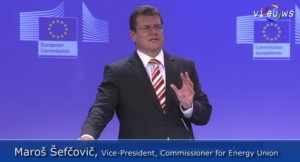
In this Brussels Briefing on Energy for viEUws – the EU Policy Broadcaster, leading journalist Hughes Belin provides an overview ofprogress made on the EU’s Energy Union project, ahead of the formal launch of the Energy Union by the European Commission on 25 February.
Climate and Energy Commissioner Cañete already revealed a series of actions to materialise the Energy Union:
• 10-point plan for energy security that includes: regulation on security of electricity supply, plans for a common gas purchasing platform, a new Liquefied Natural Gas strategy, progress on a Mediterranean gas hub & the Southern Gas Corridor
• Implementing the internal energy market
Biomass in a carbon-negative power system

Deployment of bioenergy with carbon capture and sequestration would help western North America achieve a carbon-negative power system by 2050.
Geneva talks: countries agree draft text for deal to fight climate change

Almost 200 countries agreed a draft text for a deal to fight climate change on Friday, but put off hard choices about narrowing down a vast range of options for limiting a damaging rise in temperatures.
Government delegates adopted the 86-page draft as the basis for negotiations on the deal due to be agreed later this year.
But the document includes radically varying proposals for slowing climate change – one foresees a phase-out of net greenhouse gas emissions by 2050, for instance, while another seeks a peak of emissions “as soon as possible”.
Shell chief calls for fossil fuel industry to join climate debate

The chief executive of Shell addressed the oil industry on Thursday to highlight the role of fossil fuels in the transition to a low carbon economy and attacked some critics for peddling impractical solutions to climate change.
Ben van Beurden (pictured right) told delegates at the International Petroleum Week that energy companies should not “keep a low profile” in the debate on how to reduce greenhouse gas (GHG) emissions, but should accept the challenges being posed to the industry by international carbon reduction targets.
vanBeurden said: “Our industry should be less aloof, more assertive. We have to make sure that our voice is heard by members of government, by civil society and the general public.”
A low-carbon society: global visions, pathways, and challenges

The feasibility of two low-carbon society (LCS) scenarios, one with and one without nuclear power and carbon capture and storage (CCS), is evaluated using the AIM/Enduse[Global] model. Both scenarios suggest that achieving a 50% emissions reduction target (relative to 1990 levels) by 2050 is technically feasible if locally suited technologies are introduced and the relevant policies, including necessary financial transfers, are appropriately implemented. In the scenario that includes nuclear and CCS options, it will be vital to consider the risks and acceptance of these technologies. In the scenario without these technologies, the challenge will be how to reduce energy service demand. In both scenarios, the estimated investment costs will be higher in non-Annex I countries than in Annex I countries. Finally, the enhancement of capacity building to support the deployment of locally suited technologies will be central to achieving an LCS.
What role for carbon markets in the 2015 climate agreement?
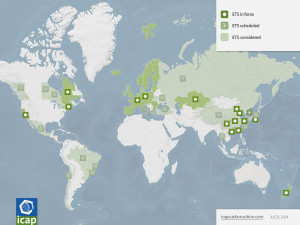
Around the world governments are increasingly pursuing market-based approaches to reduce their greenhouse gas (GHG) emissions. South Korea’s emissions trading scheme entered force at the start of this year and is currently the world’s second largest carbon market. Many other carbon pricing policies are either in force or in the planning stages, including in emerging markets such as Brazil, China, and Mexico as illustrated in Figure 1.
Parties to the UN Framework Convention on Climate Change (UNFCCC) are due to meet in Paris, France later this year to finalise a new global climate agreement to replace the current Kyoto Protocol and the Copenhagen Accords when these expire at the end of this decade.

















